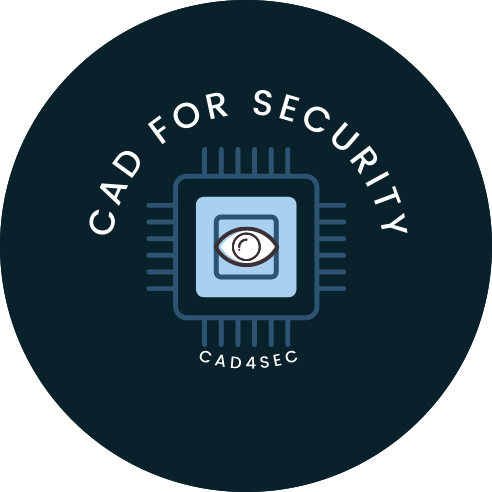TRACK CO-CHAIR: NAVID ASADI
Overview
The lack of traceability in the globalized electronics supply chain results in the infiltration of various counterfeit electronic parts, including recycled, remarked, overproduced, cloned, out-of-spec/defective, forged documentation, and tampered types and pose a severe threat to the security of our critical infrastructures. Among them, recycled, remarked, and cloned parts constitute most counterfeit incidents. Over the years, a class of solutions has been proposed to mitigate the widespread infiltration of these fake parts. Physical Inspection methods have gained a lot of attention due to their one-size-fits-all nature as the same methods can be applied to all types of parts (analog, digital, memory, FPGAs. etc.). Among various modalities, including optical, X-ray, thermal, electron beam microscopy, etc., optical imaging is one of the fastest and most affordable modalities.
This challenge requires the competitors to develop a highly-accurate automated method to identify counterfeit ICs from their labeled optical images. The minimum accuracy requirement is at least 60%. Detailed requirements are given in the following table.
| Accuracy Range | Competition Ranking Categories |
|---|---|
| 90%-100% | Gold |
| More than or equal to 80%, but less than 90% | Silver |
| More than or equal to 70%, but less than 80% | Bronze |
| More than or equal to 60%, but less than 70% | Qualified, but no specified ranking |
| Less than 60% | Disqualified |
Dataset Overview
The image data presented here is collected using the FICS lab facilities with two different image acquisition modalities:
- DSLR system with color normalization,
- Zeiss Stemi 508 Stereo Microscope.
Training Data
The challenge package includes a folder called ‘train’, which contains two subfolders named ‘DSLR’ and ‘STEMI_508’. Inside the ‘DSLR’ folder, there are 40 high-resolution images (both authentic and counterfeit) of the front and the back surface of 3 different types of ICs. On the other hand, the ‘STEMI_508’ folder includes 60 high-resolution images (both authentic and counterfeit) of the front and the back surface of the same 3 types of ICs mentioned for DSLR. The ‘train’ folder also contains an annotation file called ‘train.csv’, which has 8 columns as mentioned below:
- id – Unique identifier for each sample image. For example, the id A-M-16DIP-00F-D has 5 portions which contain 5 information of the sample:
- A – Authentic
- M – Mouser Electronics (Vendor Acronym)
- 16DIP – 16 pins dual in-line package (Package type)
- 00F – 00 refers to the first image, i.e., serial number, and F refers to the Front side image
- D – DSLR (image acquisition modality)
- sample_name – Manufacturer Product Number. For example, STM32F105R8T7
- manufacturer – Manufacturing company’s name. For example, STMicroelectronics
- vendor – Name of the entity that supplies the product (IC). For example, Digi-Key Electronics
- product_type – Type of the IC. For example, DAC (Digital-to-Analog converter) or Embedded – Microcontrollers
- package_type – Type of the IC package. For example, 16DIP (16 pins dual in-line package)
- modality – Type of image acquisition modality. For example, DSLR or Stereo Microscope
- label – 0 (authentic) or 1 (counterfeit)
Test Data
The challenge package includes another folder called ‘test’, which contains two subfolders named ‘DSLR’ and ‘STEMI_508’. Inside the ‘DSLR’ folder, there are 10 high-resolution images (both authentic and counterfeit) of the front and the back surface of a single type (different from training data) of ICs. On the other hand, the ‘STEMI_508’ folder includes 10 high-resolution images (both authentic and counterfeit) of the front and the back surface of the same type of IC mentioned for DSLR. The ‘test’ folder also contains an annotation file called ‘test.csv’, with the same column information mentioned in the training data.
Submission Criteria
- The participants are required to submit a zip file containing codes, sample submission, demo, and presentation. The file name should be “team_name_HOST_2022_SCS.zip” using OneDrive.
- Code: Can be in any language, i.e., python (recommended) /R/Java/C++ etc.
- A GitHub repository containing all necessary codes/libraries/helper functions to train, test, and visualize with a complete and comprehensive README file to implement on the hold-out test data.
- If the README file and Demo video (see below) don’t work/cannot help in successful implementation as claimed in the presentation (see below) and demo (mentioned later), the competitor will receive a penalty.
- Sample submission: a ‘sample_submission.csv’ file containing two columns –
- id – Unique identifier for each sample test image as in ‘test.csv’
- predicted_label – 0 (if the prediction is ‘authentic’ for a certain sample test image), 1 (if the prediction is ‘counterfeit’ for a certain sample test image)
- Demo: a demo video link (upload in OneDrive) to demonstrate how to run the developed system (train, test, and visualize).
- Time limit: minimum – 5 mins, maximum – 30 mins, recommended – 15 mins
- Presentation: A PowerPoint presentation of a minimum 5 to maximum 15 slides in format to show the outcome (must include the method, results, and discussion).
Evaluation Criteria***
Total: 100 pts
- Training Strategy (e.g., Cross-validation, Data augmentation, Pre-processing, etc.) – 20 pts
- Model Complexity – 10 pts
- Model Performance (Accuracy*, Confusion Matrix, Precision, Recall, F-Score, ROC AUC Score, The Matthews Correlation Coefficient (MCC) ) – 30 pts
- Highly accurate on only DSLR images – 10 pts
- Highly accurate on only Stereo Microscope images – 10 pts
- Highly accurate on both DSLR and Stereo Microscope images – 30 pts
- Model’s Generalizability/Robustness – 10 pts (To clarify, it will be examined how consistent the model’s performance is over different dataset distribution and/or adversarial examples)
- Inference time/Computational Cost – 20 pts
- Model’s scalability – 10 pts
- Model’s explainability** – 10 pts (Bonus)
* Mandatory
**Optional
***Tentative
Some external resources for more clarification
More about counterfeit IC detection:
Model’s Performance Metrics:
Model’s Generalizability/Robustness :
- https://ieeexplore.ieee.org/stamp/stamp.jsp?tp=&arnumber=7780854&tag=1
- https://proceedings.neurips.cc/paper/2020/hash/61d77652c97ef636343742fc3dcf3ba9-Abstract.html
Model’s scalability:
- https://www.codementor.io/blog/scaling-ml-6ruo1wykxf
- https://www.codementor.io/blog/scalable-ml-models-6rvtbf8dsd
- https://neptune.ai/blog/how-to-scale-ml-projects
Model’s explainability:
